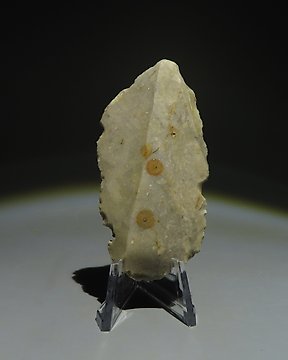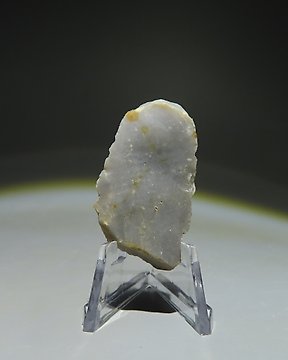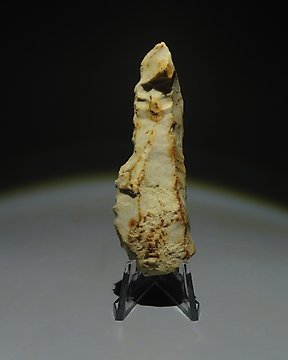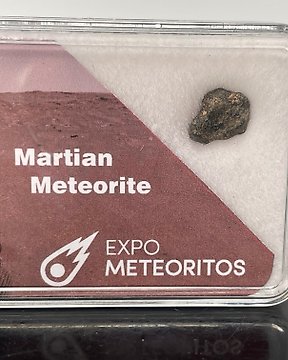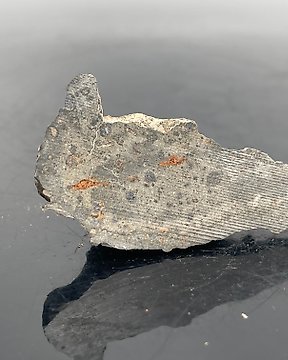Magnifique témoin du passé, envoyé avec tous les justificatifs, impeccable. Encore une fois très satisfait, un grand merci
Ver traducciónNeolítico Sílex Herramienta. Cultura Michelsberg (encontrada en Spiennes, Mons, Bélgica). 4,3cm.
N.º 84860817
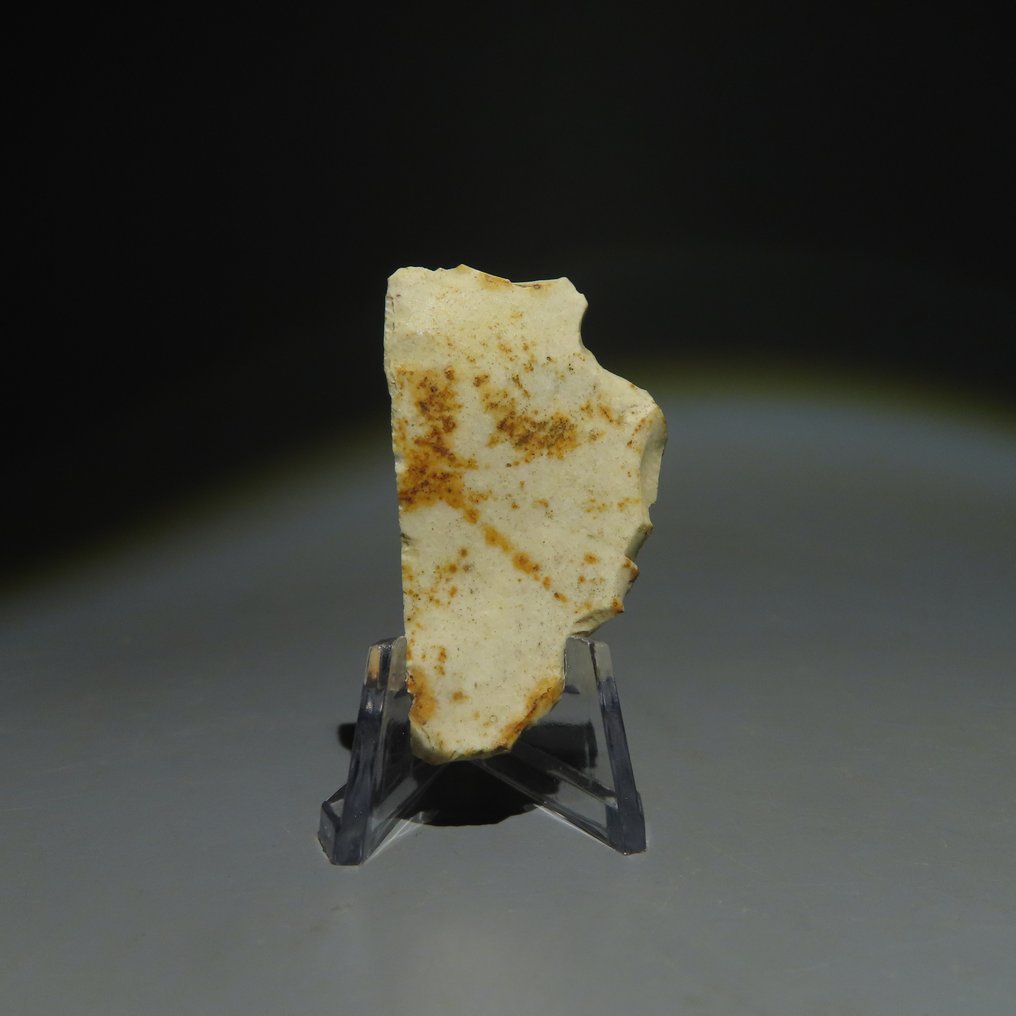
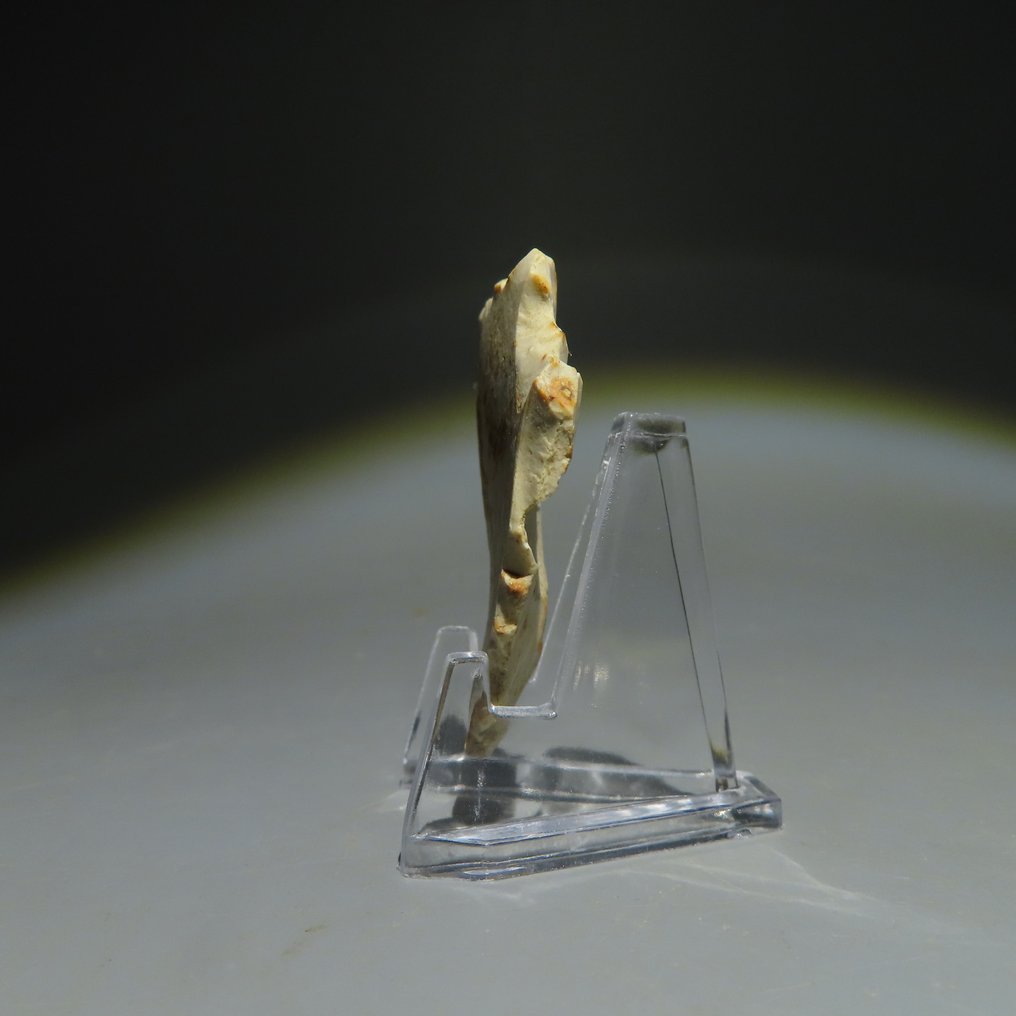
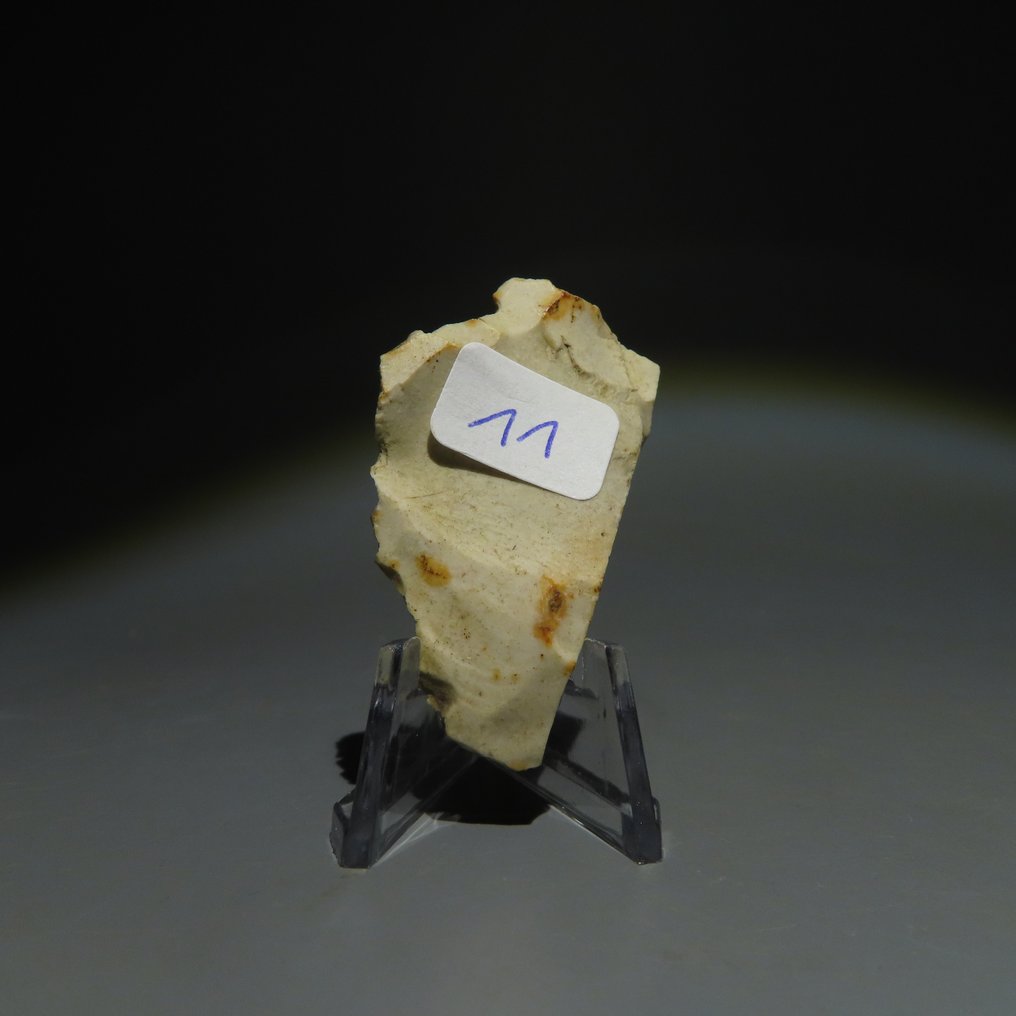
Flint tool
Michelsberg Culture (found in Spiennes, Mons, Belgium).
Neolithic Period, circa 4500-3500 B.C.
Height 4,3 cm H
PROVENANCE:
- Found in 1979 at Camp-à-Cayaux, near Spiennes (Mons), Belgium.
- Then in the holdings of a private museum in Amersfoort, the Netherlands.
- Acquired from this by the Dutch antique dealer W. Stormbroek.
- Acquired as a group when it closed down in 2010. Since then in the inventory of the Galerie Alte Römer, Germany.
- Spanish private collection.
CONDITION: Unrestored, as found.
PARALLELS: For similar material see Centre de Recherche Archéologique du Camp à Cayaux (Spiennes, Belgique).
DOCUMENTS:
- Export license issued by the Ministry of Culture, Madrid, Spain.
DESCRIPCTION:
The Michelsberg culture belongs to the Central European Late Neolithic. Its distribution covered much of West Central Europe, along both sides of the Rhine. A detailed chronology, based on pottery, was produced in the 1960s by the German archaeologist Jens Lüning. Its dates are c. 4400–3500 BC. Its conventional name is derived from that of an important excavated site on Michelsberg (short for Michaelsberg) hill near Untergrombach, between Karlsruhe and Heidelberg (Baden-Württemberg).
The Neolithic Flint Mines of Spiennes occupy two chalk plateaux located to the south-east of the city of Mons. They cover an area essentially devoted to agriculture. The site appears on the surface as a large area of meadows and fields strewn with millions of scraps of worked flint. Underground, the site is an immense network of galleries linked to the surface by vertical shafts dug by Neolithic populations.
The Neolithic Flint Mines of Spiennes are the largest and earliest concentration of ancient mines of north-west Europe. The mines were in operation for many centuries and the remains vividly illustrate the development and adaptation of mining techniques employed by prehistoric populations in order to exploit large deposits of a material that was essential for the production of tools and cultural evolution generally. They are also remarkable by the diversity of technical mining solutions implemented and by the fact that they are directly linked to a habitat contemporary to them.
In the Neolithic period, (from the last third of the 5th millennium until the first half of the 3rd millennium), the site was the centre of intensive flint mining present underground. Different techniques were used, the most spectacular and characteristic of which was the digging out of shafts of 0.8 to 1.20m in diameter with a depth down to 16 metres. Neolithic populations could thus pass below levels made up of large blocks of flint (up to 2m in length) that they extracted using a particular technique called ‘striking’ (freeing from below with support of a central chalk wall, shoring up of the block, removal of the wall, removal of the props and lowering of the block). The density of the shafts is important, as many as 5,000 in the zone called Petit Spiennes (14 ha), leading to criss-crossing of pits and shafts in some sectors.
The neolithic flint mines near Spienne in Belgium are part of UNESCO's world heritage since the year 2000 (Id. N°: 1006). With the second half of the 5. Millenium BC stone from the Spienne mine was worked in socially increasingly complex neolithic groups in that region. No doubt a source of wealth to that cultures.
The groups of that area are refered to as Michaelsberg culture. They flourished from the mid 5th Millenium BC until the mid 4th Millenium BC in middle Europe. Their culture streched from Germany, northern France to Belgium. Around Spienne, it was finally replaced by the Seine-Oise-Marne culture, which did not use the nearby mine anymore
Notes:
The seller guarantees that he acquired this piece according to all national and international laws related to the ownership of cultural property. Provenance statement seen by Catawiki.
The piece includes authenticity certificate.
The piece includes Spanish Export License (Passport for European Union) - If the piece is destined outside the European Union a substitution of the export permit should be requested. This process could take between 1 and 2 months.
El vendedor y su historia
Flint tool
Michelsberg Culture (found in Spiennes, Mons, Belgium).
Neolithic Period, circa 4500-3500 B.C.
Height 4,3 cm H
PROVENANCE:
- Found in 1979 at Camp-à-Cayaux, near Spiennes (Mons), Belgium.
- Then in the holdings of a private museum in Amersfoort, the Netherlands.
- Acquired from this by the Dutch antique dealer W. Stormbroek.
- Acquired as a group when it closed down in 2010. Since then in the inventory of the Galerie Alte Römer, Germany.
- Spanish private collection.
CONDITION: Unrestored, as found.
PARALLELS: For similar material see Centre de Recherche Archéologique du Camp à Cayaux (Spiennes, Belgique).
DOCUMENTS:
- Export license issued by the Ministry of Culture, Madrid, Spain.
DESCRIPCTION:
The Michelsberg culture belongs to the Central European Late Neolithic. Its distribution covered much of West Central Europe, along both sides of the Rhine. A detailed chronology, based on pottery, was produced in the 1960s by the German archaeologist Jens Lüning. Its dates are c. 4400–3500 BC. Its conventional name is derived from that of an important excavated site on Michelsberg (short for Michaelsberg) hill near Untergrombach, between Karlsruhe and Heidelberg (Baden-Württemberg).
The Neolithic Flint Mines of Spiennes occupy two chalk plateaux located to the south-east of the city of Mons. They cover an area essentially devoted to agriculture. The site appears on the surface as a large area of meadows and fields strewn with millions of scraps of worked flint. Underground, the site is an immense network of galleries linked to the surface by vertical shafts dug by Neolithic populations.
The Neolithic Flint Mines of Spiennes are the largest and earliest concentration of ancient mines of north-west Europe. The mines were in operation for many centuries and the remains vividly illustrate the development and adaptation of mining techniques employed by prehistoric populations in order to exploit large deposits of a material that was essential for the production of tools and cultural evolution generally. They are also remarkable by the diversity of technical mining solutions implemented and by the fact that they are directly linked to a habitat contemporary to them.
In the Neolithic period, (from the last third of the 5th millennium until the first half of the 3rd millennium), the site was the centre of intensive flint mining present underground. Different techniques were used, the most spectacular and characteristic of which was the digging out of shafts of 0.8 to 1.20m in diameter with a depth down to 16 metres. Neolithic populations could thus pass below levels made up of large blocks of flint (up to 2m in length) that they extracted using a particular technique called ‘striking’ (freeing from below with support of a central chalk wall, shoring up of the block, removal of the wall, removal of the props and lowering of the block). The density of the shafts is important, as many as 5,000 in the zone called Petit Spiennes (14 ha), leading to criss-crossing of pits and shafts in some sectors.
The neolithic flint mines near Spienne in Belgium are part of UNESCO's world heritage since the year 2000 (Id. N°: 1006). With the second half of the 5. Millenium BC stone from the Spienne mine was worked in socially increasingly complex neolithic groups in that region. No doubt a source of wealth to that cultures.
The groups of that area are refered to as Michaelsberg culture. They flourished from the mid 5th Millenium BC until the mid 4th Millenium BC in middle Europe. Their culture streched from Germany, northern France to Belgium. Around Spienne, it was finally replaced by the Seine-Oise-Marne culture, which did not use the nearby mine anymore
Notes:
The seller guarantees that he acquired this piece according to all national and international laws related to the ownership of cultural property. Provenance statement seen by Catawiki.
The piece includes authenticity certificate.
The piece includes Spanish Export License (Passport for European Union) - If the piece is destined outside the European Union a substitution of the export permit should be requested. This process could take between 1 and 2 months.
El vendedor y su historia
- 746
- 6
- 0
Thank you for the Special offer and the fast shipping of this excellent piece of art!
Ver traducciónvery good description of the object, very good price for this rare item,. Fast sending (has been at my place 2 days after buying!). Definitely would buy again.
Ver traducciónSehr schön
Ver traducciónAs described, perfect logistic
Ver traduccióngreat seller, everything came as should with certificate of authenticity
Ver traducciónExceptionally well packaged, description aligned with positing received
Ver traducciónReally precious, but without sound...
Ver traducciónPainting well packed and rapidly sent!
Ver traducciónsempre grande rapidità e professionalità
Ver traducciónparfait bien reçu, merci
Ver traducciónVery satisfied with the small Greek Lekythos. As always (we have already bought several items from Bagot), the object was wrapped and sent immediately and with the greatest care.
Ver traducciónPerfect, excellent condition, good packaging, the parcel arrived without any problems… all is perfect as usual. Thank you very much and wait for an other nice piece like this one. Gilles.
Ver traducción+++ Top vendeur professionnel comme d'habitude
Ver traducciónEmbora o custo de transporte esteja acima da média foi, realmente, muito bem executado e em embalagem cuidada. Expeditos e profissionais. Recomendo
Ver traducciónSnel en correct en goed verpakt verzonden
Ver traducciónoggetto bellissimo, fedele alla descrizione, venditore affidabile
Ver traducciónVery nice piece and fast delivery
Ver traducciónEverything ok, top seller! Thank you again!
Ver traducciónvery beautiful and fast shipping!thank you!
Ver traducciónExcelent, very good piece++++
Ver traducciónVendedor increíble muy buenos he comprado muchas veces todo perfecto. Muchas gracias
Ver traducciónpas de problème ; merci beaucoup
Ver traduccióntres rapide conforme hope next +++
Ver traducciónSehr schön! Vielen Dank!
Ver traducción- 746
- 6
- 0
Magnifique témoin du passé, envoyé avec tous les justificatifs, impeccable. Encore une fois très satisfait, un grand merci
Ver traducciónAviso legal
El vendedor garantiza y puede probar que el objeto ha sido obtenido legalmente. Catawiki ha informado al vendedor de que tenía que proporcionar la documentación exigida por las leyes y reglamentos de su país de residencia. El vendedor garantiza que tiene derecho a vender/exportar este objeto. El vendedor le proporcionará al comprador toda la información disponible sobre la procedencia del objeto. El vendedor garantiza que se tramitarán todos los permisos necesarios. El vendedor informará inmediatamente al comprador de cualquier retraso en la obtención de dichos permisos.
El vendedor garantiza y puede probar que el objeto ha sido obtenido legalmente. Catawiki ha informado al vendedor de que tenía que proporcionar la documentación exigida por las leyes y reglamentos de su país de residencia. El vendedor garantiza que tiene derecho a vender/exportar este objeto. El vendedor le proporcionará al comprador toda la información disponible sobre la procedencia del objeto. El vendedor garantiza que se tramitarán todos los permisos necesarios. El vendedor informará inmediatamente al comprador de cualquier retraso en la obtención de dichos permisos.

